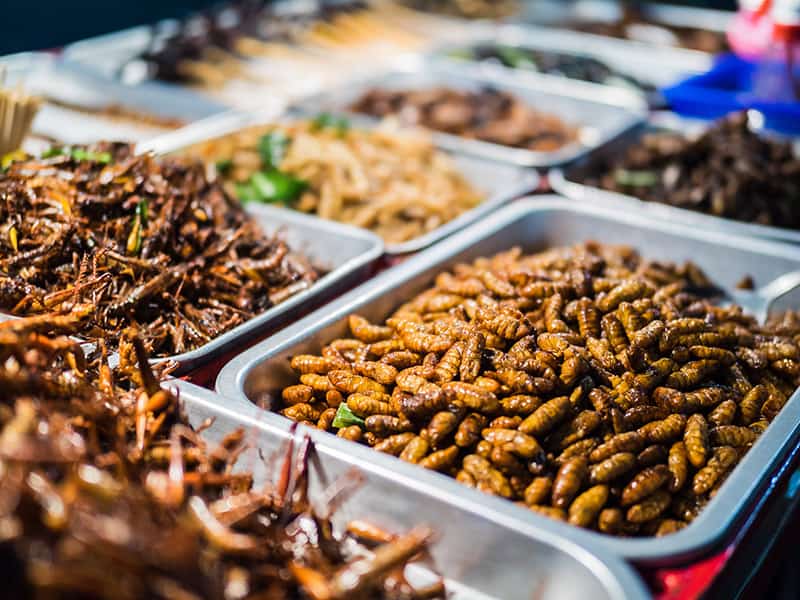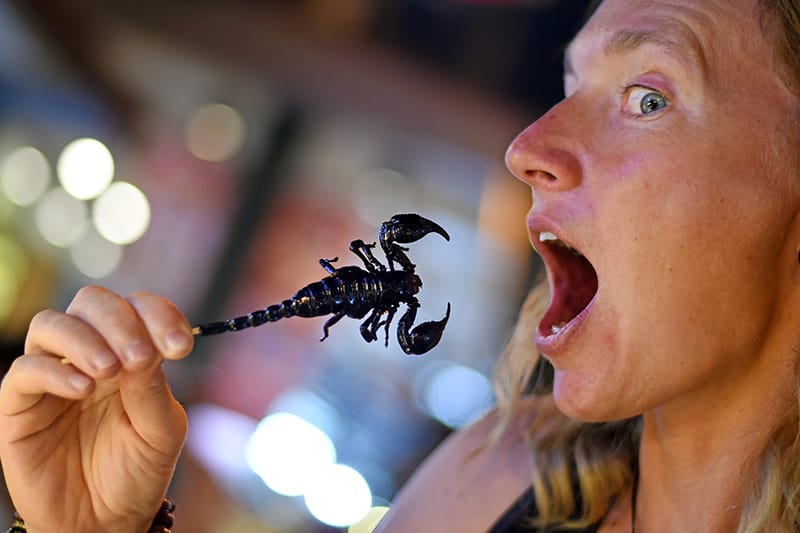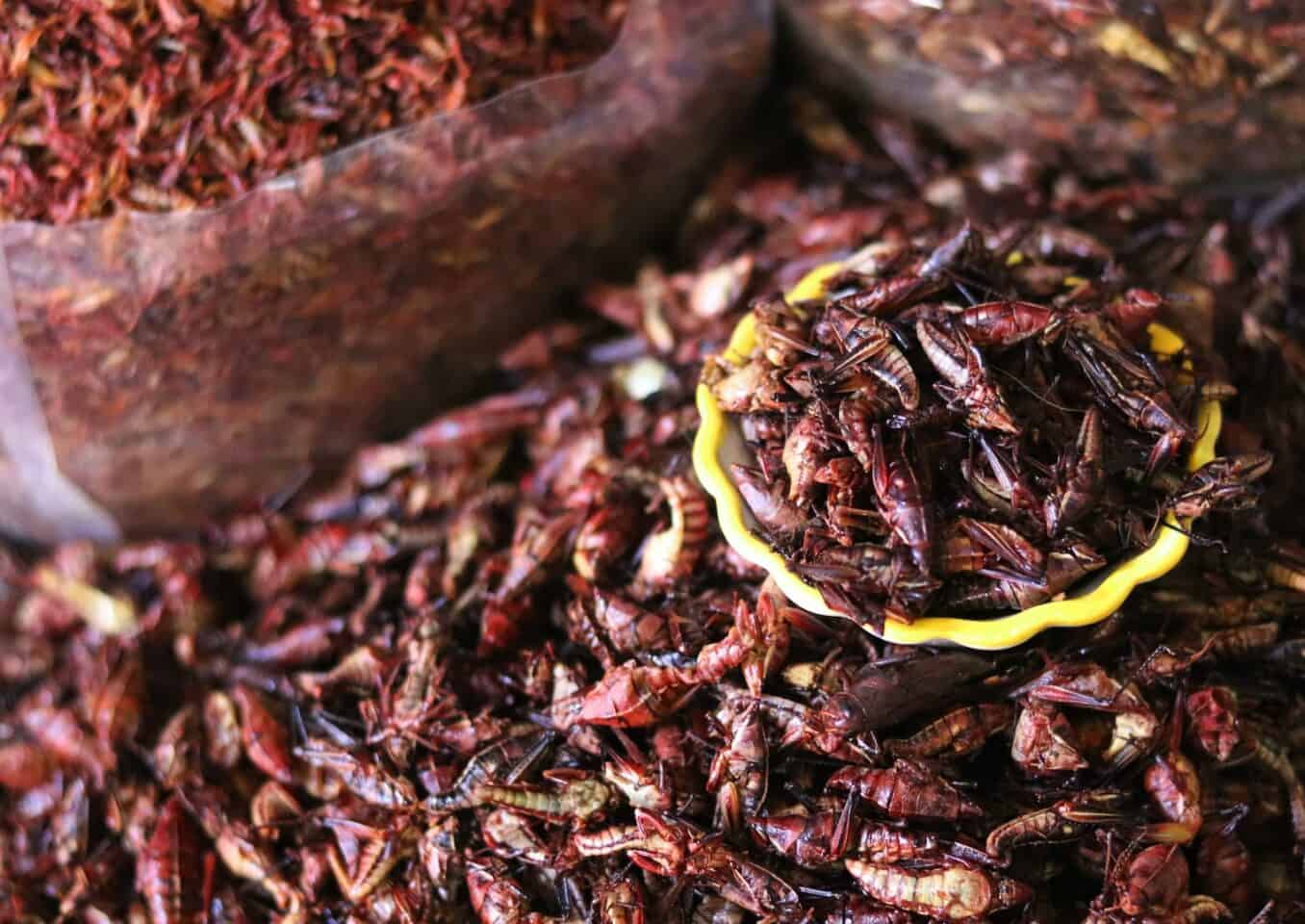Is it time to revisit the Paleo Diet, and go beyond to a diet of insects, bugs, and arthropods?
The idea of snacking on bugs reminds me of Pumbaa in the Lion King movie, smacking his lips and contentedly saying, “Slimy… yet satisfying!” Bugs are small compact packages of food packed with nutrition. But are they scrumptious? That depends on where you live and how you were raised.
Imagine sitting down to the dinner table where the usual fare is accompanied with a selection of succulent dishes concocted with bugs. That may make you a little squeamish if you didn’t grow up with it. People in Western cultures tend to be abhorred by the idea of eating anything that crawls around with six, eight, or more, legs. Yet there are many cultures where the consumption of bugs is commonplace.
Bugs are eaten in 80% of the world’s nations. It’s estimated that between 1,400 to 2,000 species of bugs are eaten in more than 100 countries. These include butterflies and moths, beetles, ants, bees and wasps, grasshoppers, crickets, cockroaches, termites, cicadas, dragonflies, and more. Even before hunting or farming became prevalent methods of food production, insects and other creepers are believed to have been an integral part of the human diet.

Bugs and the Paleolithic Diet
The latest diet craze, the Paleolithic Diet, takes it cues from the Stone Age. The recently popular best seller by Dr. Loren Cordain, The Paleo Diet, reflects this age as the idea behind this diet. Basically, if our early ancestors couldn’t have eaten something, than we shouldn’t be eating it today.
Cordain and other Paleo Diet advocates and researchers emphasize early man as skilled, aggressive hunters, feeding the tribes on meat. Paleo Diet advocates make an excellent point. Hunting and gathering were not only a primary part of our evolution, but are still vital practices throughout the world today.
According to Daniella Martin, in her article The benefits of eating bugs, Meet the new Paleo diet, “Cordain suggests that prior to the agricultural revolution, early humans ate this Paleo Diet for 2.5 million years.” And he further points out that farming, popular for only the last 10,000 years, is just a “drop in the chronological bucket when compared with the millennia leading up to it. He further says that “the hunter-gatherer diet our ancestors lived on is far more deeply and indelibly imprinted into our DNA than our habits of the last few thousand years.”
Yet Martin’s article is very insightful on another front, that of bugs! She suggests that in the long evolution of man, there are piles of evidence indicating that early man may very well have gotten a significant portion of their diet from insects and other creepy crawlers.
She describes how early hunters could score a big game kill on average only about 20% of the time. If this had been their only food source, they would have starven. To feed the tribe in between kills their regular fare would have to include lots of food items they could gather and forage. She says these would include tubers and greens along with small animals, the bulk of which would be insects and other invertebrates.

Bugs, nutritious and delicious
The practice of humans eating bugs for food is called Entomophagy. Animals that eat insects are known as insectivores.
An Entomophaga diet primarily consists of insects, those six-legged creepy crawlers with two antenae, but it also includes certain arthropods. Arthropods are not insects but are still creepers. These include arachnids like spiders, tarantulas and scorpions, and myriapods like centipedes. Crustaceans like crabs, lobsters and shrimp are also arthropods, but they are not included in the definition of Entomophagy. Animals that eat insects are known as insectivores.
The nice thing about eating bugs, from a nutritional standpoint, is they have so many of the things that the human body needs. They contain protein, iron, calcium, the healthy unsaturated essential fatty acids (EFAs), and other nutrients.
Martin says they are a much higher quality food compared to things like leaves, fruits, flowers, and nuts. Plant sources do contain many of these same nutrients, but in a much smaller concentration. She indicates the difference is because “insects are a two food source — they themselves have eaten, and thereby concentrated in their own tissues, the nutrients found in plant sources.” For people, this higher concentration means less work for the same nutritional benefits.

Bugs, on the market
There are some food bugs available in the US, but these are mostly found in specialty restaurants or as novelty snack items. Some of these delectable items are:
- Chocolate-covered insects: These edible, farm-raised insects include scorpions, superworms, silkworms, bees, ants, and crickets.
- Crickets: Farm-raised crickets can be found flavored with salt & vinegar, bacon & cheese, and sour cream & onion.
- Larvets Worm Snacks: These edible, farm-raised larva are flavored in cheddar cheese, BBQ, bacon & cheese, and Mexican Spice.
- Casu marzu: More commonly known as maggot cheese, this is a cheese laced with maggots.
- Insect Lollipops: Transparent candy lollipops that have scorpions (the harmless California scorpions), mealworms, or crickets encased inside a delicious candy coating.
Insects and other bugs are a delicacy, and often a staple in many countries throughout the world. Here are some good food bugs, starting with mealworms and crickets which pet keepers in the US are very familiar with, and ending with some familiar arthropods:
- Mealworms: (Netherlands) Mealworms are the larvae of the mealworm beetle Tenebrio molitor. These are good sources of protein, copper, sodium, potassium, iron, zinc, selenium, and polyunsaturated fats.
- Crickets: (Taiwan) Crickets are one of the most common food items in this country. (NE Thailand) Crickets laden with eggs are considered a tasty snack in this country.
- Ants: (Malawi) Candied ants are a favorite in Malawi. (Thailand) They consume Weaver ant eggs in this country.
- Flies: (Malawi) They use flies to make fly pancakes!
- Grasshoppers: (So. Mexico) In Southern Mexico grasshoppers of the genus Sphenarium, called chapulines, are widely consumed.
- Locust: (Thailand) Locusts feed primarily on the leaves of rice plants, they became a staple when they experienced a major locust problem in this country.
- Termites: (South America, Africa, parts of Indonesia) Consuming termites is commonplace. They are rich in iron, calcium, essential fatty and amino acids, and high in protein, most with about 38%, but a species found in Venezuelan, Syntermes aculeosus, contains as much as 64%.
- Cockroaches: (Thailand) They eat many types of insects in this country!
- Giant Water Beetles: (Thailand)
- Stink Bugs: (Asia, South America, Africa). These insects are rich in nutrients including protein, iron, potassium and phosphorus.
- African Palm Weevil: (Africa) This insect is fatty along with potassium, zinc, iron, phosphorous, several amino acids, monounsaturated and polyunsaturated fatty acids.
- Mopane Caterpillars: (So. Africa) Mopane caterpillars are the larval stage of the Emperor Moth Imbrasia belina.
- Maguey Worms: (Malawi) (Mexico) Maguey Worms are the larvae of a giant butterfly, the Tequila Giant Skipper Aegiale hesperiaris.
- Witchetty Grubs: (Australia) This is a staple in the diet of the aboriginal people.
- Tarantulas: (Cambodia) These are favored delicacies here!
- Spiders: (France) Some spider species are dipped in chocolate and fried as treats. (Africa) Spiders are regularly mixed into all the meals.
- Scorpions: (Singapore, Beijing) These are a common food, usually fried and then skewered.

Bugs, solving the world’s food crisis
In a world pushing a population of 8 billion, and expected to reach 9 billion by 2050 according to the United Nations (UN), food resources are becoming stretched. Insects and other creepers are highly nutritious, readily available, and have a very efficient reproductive capacity. A growing number of experts claim that people will soon have no choice but to consume insects.
In his article, Why Insects Should Be in Your Diet, biochemist and entomologist Dr. Aaron T. Dossey says insects “hold great promise for thwarting an impending global food crisis” and he believes that they “can realistically become an important part of our future.”
Clarice Brough is a team member at Animal-World and has contributed many articles and write-ups.
Featured Image Credit: analuisa gamboa, Unsplash
